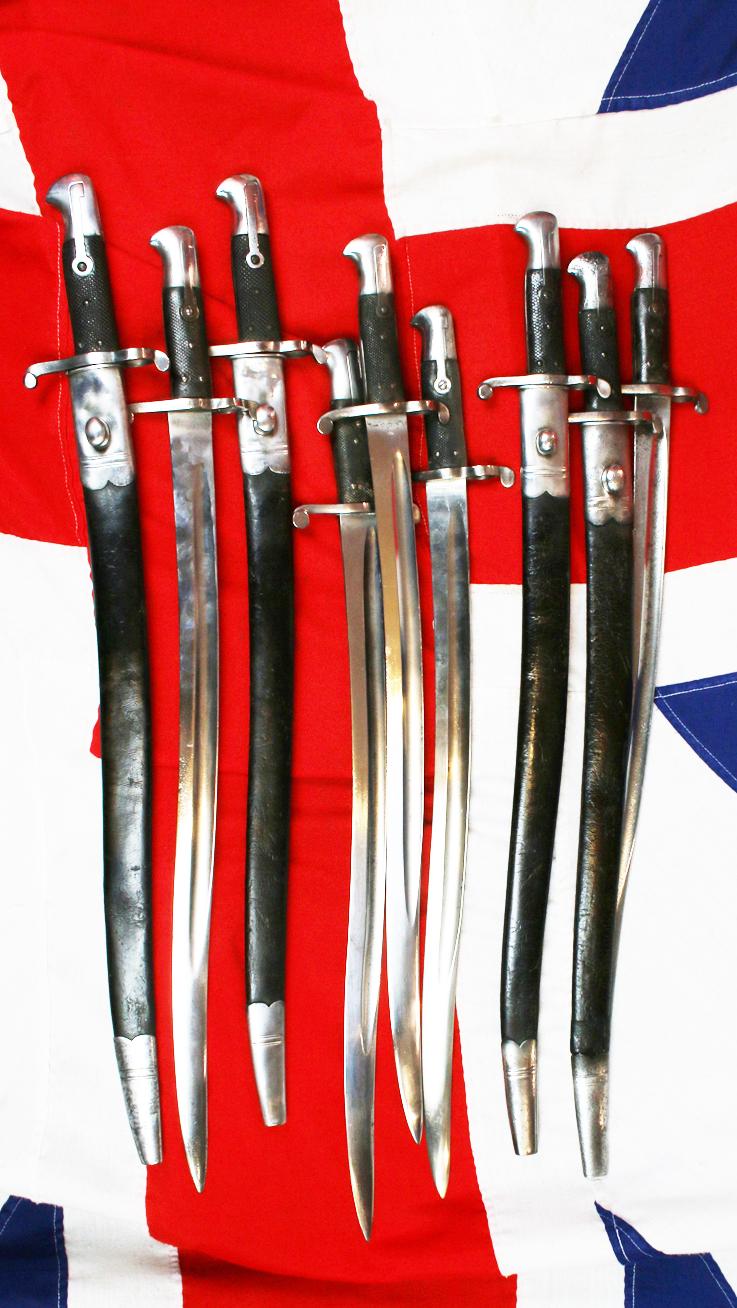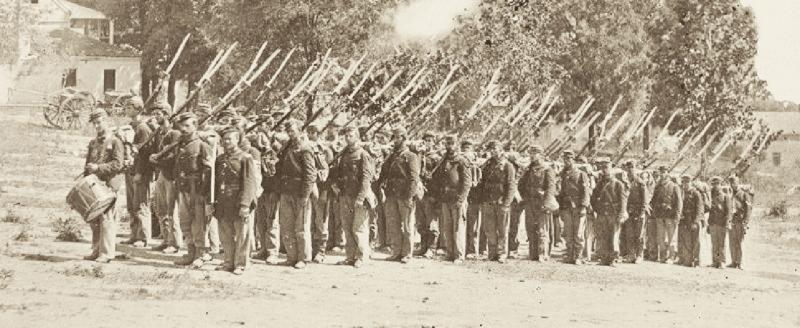Fabulous Extensive Collection of Superb Service Issue 1856-8 Two Band Enfield Yataghan Sword Bayonets. Used In The Opium War With P1853 Enfields. The 1850's War in China and the American Civil War 1861 & The Japanese Boshin War The Satsuma Rebellion
Absolutely bright as a button, all have been hand polished and conserved, for the next 200 years, in our workshop. As good as any you may see in a museum collection.
All to be sold separately, some with scabbards some without.
Original ordnance stamps and inspection marks abound, and regimental gun rack number on the hilts.
The rifle that this sword bayonet was designed for the P1853 two band Enfield rifle, and was the type used in the late Indian Mutiny at the "Seige and Relief of Lucknow". Chequered leather grip with rivets, and screw affixed retaining spring. Good, long, Yataghan blade in bright polish. Excellent leather. The regiments that used this bayonet sword took part in the Second Opium War, the Indian Mutiny and the Third Anglo-Burmese War, and tens of thousands of service issue rifles and bayonets were sold to America in the Civil war, purchased by both the North, and the South. See photos in the gallery of Union and Confederates with the Enfield rifles and their yataghan bayonets. After the Civil War thousands of Confederate purchased Enfields were sold to Japan's Tokugawa Shogunate, and used in the Boshin war and the Satsuma Rebellion.The Boshin War (戊辰戦争, Boshin Sensō), sometimes known as the Japanese Revolution or Japanese Civil War, was a civil war in Japan fought from 1868 to 1869 between forces of the ruling Tokugawa shogunate and a coalition seeking to seize political power in the name of the Imperial Court.
The war stemmed from dissatisfaction among many nobles and young samurai with the shogunate's handling of foreigners following the opening of Japan during the prior decade. Increasing Western influence in the economy led to a decline similar to that of other Asian countries at the time. An alliance of western samurai, particularly the domains of Chōshū, Satsuma, and Tosa, and court officials secured control of the Imperial Court and influenced the young Emperor Meiji. Tokugawa Yoshinobu, the sitting shōgun, realizing the futility of his situation, abdicated and handed over political power to the emperor. Yoshinobu had hoped that by doing this the House of Tokugawa could be preserved and participate in the future government.
A quote from a Confederate officer's diary,
"Every short two-band Enfield which came into possession of any of our men was taken away and given to these men sharpshooters ... But there were not enough and some of them had the common long Enfield."
It would appear that by mid-war in the Confederate Service, while the infantry was provided with the longer rifle-muskets where possible, the shorter rifles (US or Enfield) were preferred for use by the Cavalry:
Gen. Basil Duke noted of Morgan's Cavalry, they did not even like the American shorter carbine length muzzle loaders (musketoons):
"Morgan's Cavalry in the west preferred the British arm they called the "medium Enfield" the two band rifle. The short Enfield carbine they found convenient to carry, but deficient in range and accuracy. The long-Enfield (three band) they found inconvenient to carry, and difficult to use (as was sometimes necessary) on horseback. Regardless, in that command one company had the long Enfield, another the short, and another the medium.
We bought the entire small collection from the widow of a 'best of British Empire rifles and bayonets, plus French and German bayonets collector’, who acquired them over the past 40 plus years, and only ever kept the very best he could afford to keep. Act fast they are selling really fast, three rifles and eight bayonets and a cutlass have sold in two days alone. Top quality and condition,19th and 20th century scarce British French and German collectables are always the most desirable of all. These Victorian British made bayonets were all used in the above mentioned conflicts, including those here, that were eventually sold to Japan, via a very circuitous route, by America, who in their turn purchased them from England for the American Civil War. All of these were acquired by the English collector, from a former Japanese collector of Boshin War and Satsuma Rebellion militaria some decades ago. As the perfect examples of just how far travelled British made arms and bayonets journeyed around the world in their combat service life.
The Confederates imported more Enfields during the course of the war than any other small arm, buying from private contractors and gun runners and smuggling them into Southern ports through blockade running. It has been estimated that over 900,000 P53 Enfields were imported into America and saw service in every major engagement from the Battle of Shiloh (April 1862) and the Siege of Vicksburg (May 1863), to the final battles of 1865. The gun was highly sought after in the Confederate ranks. According to a survey taken by British officials during the early stages of war on the arms of the Western Confederate Forces, nearly 70% were armed with smoothbore arms, such as the Model 1842 Springfield. Later in the war the same survey was taken, they found that more than 75% had acquired a rifle, mainly the Pattern 1853 Enfield.
The P53 Enfields capabilities were largely lost by the lack of marksmanship training by both the Union and Confederacy. Most soldiers were not trained to estimate ranges or to properly adjust their sights to account for the "rainbow-like" trajectory of the large calibre conical projectile. Unlike their British counterparts who attended extensive musketry training, new Civil War soldiers seldom fired a single cartridge until their first engagement. After the end of the war, hundreds of formerly Confederate Enfield 1853 muskets were sold from the American arms market to the Tokugawa shogunate, as well as some prominent Japanese domains including Aizu and Satsuma. These units were later used in the Boshin War, and some remaining in Satsuma were also used by rebelling former samurai in the Satsuma Rebellion about a decade later.
The end of the American Civil War in 1865 had made a huge number of obsolete percussion muzzleloading rifles and rifle muskets available on the secondary market from international arms traders like Schuyler, Hartley & Graham. While these guns were being replaced with modern metallic cartridge breechloaders in most of the world, a muzzleloading Enfield pattern rifle or rifle musket was a huge technological advantage against the traditional smoothbore Tanegashima-tsutsu matchlocks in Japan. Other firearms found their way into Japan through western traders as well, ranging from Spencer Carbines to Smith & Wesson Model No 2 revolvers, and everything in between. The traders were only too happy to arm what was looking to be a Japanese civil war. It is also worth noting that there is the possibility that these bayonets, in addition to almost certainly being used by pro-Imperial forces during the Meiji Restoration of 1868-1869, may well have seen use again during the Saga Uprising of 1874 by the anti-Imperial rebels in that province. Photos in the gallery show two 1860’s Japanese anti Imperial samurai rebels armed with an Enfield rifle, with its Yataghan long sword-bayonet upon his belt, and a similar carbine version.
They will be priced for UK mainland delivery only. For export delivery, please POA.
Code: 25994
Price
on
Request









